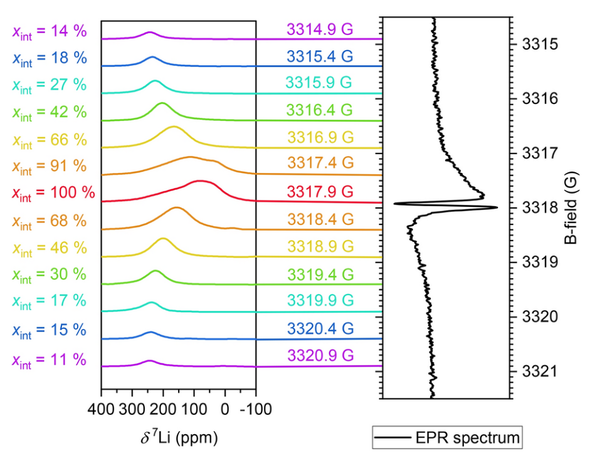Combined dynamic nuclear polarization and electron paramagnetic resonance at 0.34 T to investigate electrochemical lithium deposition on copper
DOI: 10.1038/s41598-025-01107-x

Abstract: Despite extensive research conducted on plating and dendrite formation in lithium batteries, the molecular formation processes are not yet fully understood. Electron paramagnetic resonance (EPR) sensitively detects metallic Li species but misses non-paramagnetic ones. Nuclear magnetic resonance (NMR) is chemically selective, yet exhibits low sensitivity under low-field conditions. Dynamic nuclear polarization (DNP) overcomes this by transferring electron spin polarization to nuclei. Here, correlative EPR and DNP-enhanced 7Li NMR of lithium on copper is demonstrated using a custom setup operating at 0.34 T with a sweepable electromagnet. DNP experiments were conducted in pulsed mode to minimize sample heating. The resulting enhanced 7Li NMR signal allows the observation of electrochemically deposited lithium on copper, harvested from a Cu vs. Li cell, with an enhancement ϵ > 400. By changing the magnetic field strength by a few Gauss, the saturation of the conduction EPR transition was varied, leading to an altered Knight shift of metallic 7Li. The corresponding change of the DNP-polarized 7Li chemical shifts in the range from 240 ppm to 80 ppm allowed an indirect, saturation-based distinction of EPR species. Moreover, an enhancement ϵ by a factor of about 2 of the 1H signal from the surrounding electrolyte of electrochemically deposited lithium was observed, indicating the potential to investigate the solid–electrolyte interface (SEI). The setup employed a battery cell housing developed for EPR, demonstrating its suitability for in operando experiments in the future.
Cite as: Barysch, V.M., Wolff, B., Streun, M. et al. Combined dynamic nuclear polarization and electron paramagnetic resonance at 0.34 T to investigate electrochemical lithium deposition on copper. Sci Rep 15, 18436 (2025). https://doi.org/10.1038/s41598-025-01107-x
